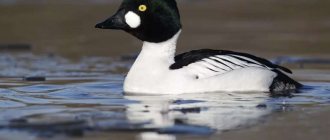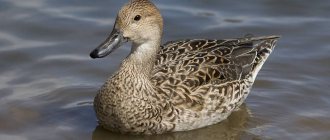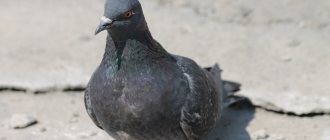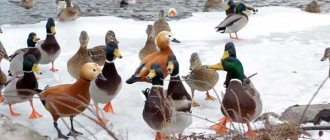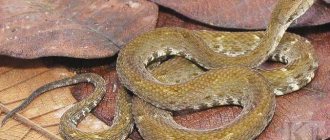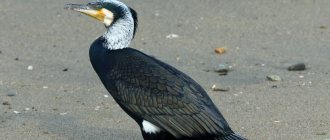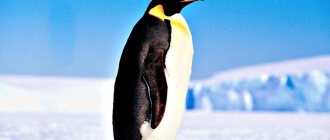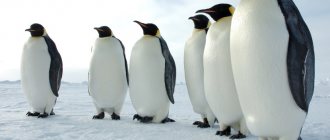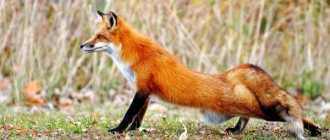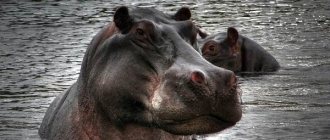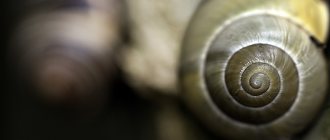Ducks are species of waterfowl with large beaks and relatively short necks in the family Anatidae, and especially in the subfamily Anatinae (true ducks). The Anatidae family also includes swans, which are larger and have longer necks than ducks, and geese, which are generally larger than ducks and have less sharp beaks.
Ducks are aquatic birds and live in fresh and marine environments. There are wild and domestic groups of birds.
Cherry Valley
The breed comes from England. The desire of British breeders was to develop a breed that would have maximum meat productivity without loss of egg production. Peking ducks were involved in the breeding. Selection was carried out simultaneously on the paternal and maternal lines, which in both cases gave good results.
Description. Externally, the birds are similar to their ancestors. At birth, the chicks receive yellow plumage, which lightens over time, becoming snow-white. The body is directed vertically, elongated. Birds have a wide chest, pronounced muscles, and feathers that fit tightly to the body. The body stands on low, strong legs of a red-orange hue. A small head with a convex forehead is located on a thick neck. The beak is curved, yellow-orange. Eyes blue or dark blue.
Productivity. The weight of the duck reaches from 3.4 to 3.7 kg. The drake weighs about 3.5 to 4 kg. Over the course of a year, a laying hen produces 120-150 large eggs weighing 70-90 g. The hatchability of young animals is about 95%.
Content. There are practically no difficulties with maintaining the breed. In order for animals to feel comfortable, they need to equip a warm room, install feeders and drinking bowls.
Advantages. The advantages of the breed include fast growth, attractive appearance, high productivity, and unpretentiousness in food.
Flaws. Birds of the Cherry Valley breed have almost no disadvantages. The only difficulty a breeder may encounter is the need for access to water and walking.
Nutrition
Coots prefer to eat plant foods. Their diet consists mostly of green algae. They feed on the following plants growing in water:
- duckweed;
- pinnate;
- hornwort;
- algae.
But sometimes they catch and eat small fish, insects, and fry. Coots destroy the homes of birds living in the neighborhood and eat eggs.
Population
Coots are numerous. These birds reproduce quickly and easily get used to a new place. The existing species of coots are stable in number and are not subject to extinction.
There are factors in the world that influence population decline:
- reed cutting;
- drainage of reservoirs;
- hunting;
- ecology.
These reasons do not have a particular impact on the number of coots. Today, for many species there is no need to apply conservation measures. But some are under protection. For example, the Hawaiian coot.
Indian runner
Previously, this breed was called the penguin. This name comes from the unusual shape of this duck species. Even at the beginning of the 20th century in Europe, the breed was considered rare, the birds exotic - ducks were exhibited in zoos.
Description. Externally, the Indian Runner differs from other duck breeds: it has a unique body shape, resembling an elongated bottle. The feathered animal has a slender and tall body with a vertical orientation and a rounded chest. The feathers are smooth, lying close to the body. The color of the plumage varies.
Productivity. The weight of adult runners can reach one and a half to two kilos. Females are smaller than drakes. Already in the first month of good fattening, ducklings catch up with adult birds in weight and size. Egg indicators are much better - a laying hen produces 200-250 large eggs per year, sometimes the number reaches 300-350 pieces.
Content. If ducks have the opportunity to graze on pasture near a pond, maintenance costs will be minimal. Indian runners can find their own food all day long.
Advantages. Animals run fast and are active. They have increased resistance to diseases. They grow quickly. They are not afraid of snow and frost.
Flaws. Ducks are shy and can panic at the slightest noise. It is not advisable to raise birds for meat.
How ducks breed
Males have a reproductive organ that is evacuated from the cloaca for copulation. Most ducks are seasonally monogamous, with pair bonds lasting only until mid-incubation or the appearance of the ducklings.
Laying eggs
The female builds a nest from leaves and grasses, lining the bottom with down collected from her own chest.
Eggs are laid from mid-March to the end of July. A typical clutch is about 12 eggs, laid one to two days apart. After each egg is added, the clutch is covered with debris to protect it from predators.
Gray duck egg laying
The duck incubates the eggs for approximately 28 days. The number of eggs a female lays is directly related to the amount of daylight available. More daylight means more eggs.
The laying period is stressful for the female, she deposits more than half her weight in eggs in a couple of weeks. The duck needs to rest, and she depends on her drake partner, he protects her, eggs, chicks, places for feeding and resting.
Mother ducks work hard to maintain their brood as the ducklings grow. Males stay with other males, but guard the territory and chase predators. Ducks lead their ducklings around shortly after they are born. Ducklings are able to fly after 5-8 weeks of life.
Description of ducks
- wide and voluminous body;
- partially webbed feet;
- a somewhat flattened beak with horny plates (miniature projections similar to “comb teeth”);
- and a hard process at the tip of the beak;
- a large coccygeal gland crowned with a tuft of feathers.
The body of ducks does not get wet in water thanks to the oils that are distributed throughout the feathers.
Zoologists divide ducks into three main groups
- Diving and sea ducks, such as the pochard, are found in rivers and lakes and forage deep underwater.
- Surface eaters, or small ducks such as mallards and wood ducks, are common in ponds and marshes and feed on the surface of the water or on land. The horny plates on the beaks of such ducks look like whalebone. These tiny rows of plates along the inside of the beak allow birds to filter water from the inside of the beak and store food inside.
- There are also ducks that hunt in open water. These are merganser and lutok, which are adapted for catching large fish.
Diving ducks are heavier than surface ducks; this anatomical feature is needed to make it easier to dive into the water. Therefore, they need more time and space to take off for flight, while small ducks take off directly from the surface of the water.
Diving ducks
The males (drakes) of the northern species have extravagant plumage, but it moults in the summer, giving the males a feminine appearance and it is difficult to distinguish the sexes. Species found in the south show less sexual dimorphism
Ducks' flight feathers molt once a year and fall out all at once, so flight is impossible during this short period of time. Most true ducks molt their other feathers (outline feathers) twice a year. When ducks are not flying, they seek out protected environments with good food supplies. This molt usually precedes migration.
Some species of ducks, mainly those that breed in temperate climates and the Arctic hemisphere, are migratory. Species that live in warm climates, especially in the tropics, do not make seasonal migrations. Some ducks, especially in Australia, where rainfall is patchy and unstable, wander, looking for temporary lakes and reservoirs that form after heavy rains.
Bashkir
Breed of meat and egg orientation. Farmers of private farmsteads and industrial enterprises especially fell in love with these birds, due to the fact that they feed on almost any food and are able to independently satisfy their needs while walking in a meadow or on a pond.
Description. Ducks have protruding chests and a strong and muscular build. Large, widely spaced paws on short orange legs. The head is flattened on the upper side, located on a short, concave neck, curved outward. A concave orange beak with a wide growth that allows the birds to grab grass. The wings fit tightly to the body. The plumage is black-gray.
Productivity. Adult drakes weigh more than 4 kg, and ducks reach 3.7 kg. There is practically no fat in the carcass. The meat yield is at least 70%. One laying hen produces from 115 to 125 eggs weighing 70-80 g per year.
Content. The bird is unpretentious in care, so it will feel good in special cages and pens. In the room for ducks, it is imperative to maintain an average temperature in winter, and set the optimal temperature in summer - it should not be hot.
Advantages. High survival rate of ducklings - about 80%. Birds also have increased resistance to infectious diseases, grow and develop quickly.
Flaws. Birds need to constantly drink clean water and change bedding, otherwise the animals may be susceptible to disease.
Agidel
When working with these ducks, breeders tried to improve not only egg and meat productivity indicators, but also increase the animals' resistance to diseases and infections. They managed to achieve this.
Description. Ducks are characterized by a deep, protruding chest, a long and wide back, and a well-set and almost horizontal body. The animals have a long and large head with dark, high-set eyes and a wide beak of a white-pink hue. The neck is slightly thickened and relatively long. The body is firmly supported by short legs of a light orange hue. The plumage is white.
Productivity. The breed is valued for its high productive qualities. At the age of 2 months, birds weigh 3 kg. During this period, if the bird is not kept for breeding or keeping eggs, it is sent for slaughter. A duck produces up to 250 large eggs weighing up to 100 g in one season.
Content. Animals do not need permanent poultry houses because they can easily tolerate temperature changes. The only thing that is important to avoid is drafts. There must be a bowl of water in the room so that the birds can moisten their feathers.
Advantages. Agidel ducks quickly gain weight, produce a lot of eggs per year, and have increased resistance to diseases. The taste of meat is especially valued by farmers.
Flaws. Receiving a brood from an incubator due to poorly developed maternal instinct, fatty meat.
Mulards
Breeders created a hybrid in order to improve the qualities of the parent breeds to obtain a new, improved specimen. For crossing, indo-duck and domestic duck of the Peking white, Rouen, etc. breeds are used.
Description. The birds have a special appearance, making them difficult to confuse with other ducks. The sizes are large, the body is dense and elongated. On a strong, long neck there is an oval, small head. The body is supported on strong legs with short yellow-orange legs. The eyes are dark, the beak is flat, light yellow, and slightly elongated. The feathers fit tightly to the body. The feather color is predominantly white. The birds are calm, not noisy and clean.
Productivity. The hybrid has high productive qualities. In the first 2-3 months, ducks weigh 3.5-4 kg; at four months of age, body weight reaches about 6 kg. Duck meat is lean, especially valued in cooking and considered a delicacy.
Content. It is permissible to keep ducks in an insulated shed where they will spend the night. Birds also need to be given free space to walk. The temperature in the poultry house should be no lower than +16 and no higher than +25 degrees.
Advantages. Calm disposition, precociousness, cleanliness, high meat performance, ease of care.
Flaws. Mulards are not found in the wild and are not able to reproduce on their own. Birds are raised exclusively at home.
A breeder of Mulardy ducks shares his experience of breeding them in the following video:
Ukrainian gray
Meat poultry, which is considered one of the best breeds of this type. The breed was bred by Ukrainian breeders.
Description. Birds have a wide muscular body, a powerful physique and fragile bones. The beak is dark, slightly concave. The animals have thick plumage, similar in color to that of their wild counterparts. Specimens with clay or white plumage are usually found.
Productivity. The little ducklings grow and develop well and gain weight quickly. Already at 2 months the weight of birds reaches 3.5-4 kg. Over the course of a year, one hen produces up to 120 large eggs weighing 85-90 g.
Content. Ducks of this breed are able to fully develop on grazing and independently obtained duckweed alone. The breed can be kept in unheated poultry houses. The main thing is to provide thick bedding and protect the house from drafts.
Advantages. Good productive performance, increased resistance to low temperatures and bird diseases. They also distinguish early maturity, intensive growth, and a high survival rate of chicks.
Flaws. The birds are unclean and also noisy.
Where does it live?
Coots inhabit many areas of the globe. They can be seen:
- on the continent of Eurasia;
- in northern Africa;
- in Australia;
- in New Guinea;
- in America.
The vast area of the bird's range can be explained by the fact that long-distance flights are unacceptable for them. If they choose a place during the flight, they can stay there and do not return to their original place.
Steppe and forest-steppe zones were occupied by coots on Russian territory. Their places of settlement are reed and grass thickets near lakes and in the floodplains of slow-flowing rivers.
Ducks and people
Ducks - as an animal group - serve many environmental, economic, aesthetic and recreational purposes. They are an integral part of the food chain ecosystem, farmed by humans for their feathers, eggs and meat, valued for their beauty of form, behavior and color, and are a popular game species for hunters.
All domestic ducks are descended from the wild mallard, Anas platyrhynchos, except Muscovy ducks. Many domestic breeds are much larger than their wild ancestors, measuring 30 cm or more from base of neck to tail, and are capable of swallowing larger foods than wild relatives.
Ducks in populated areas take up residence in local public ponds or canals. Migration has changed; many species remain for the winter and do not migrate to the South.
Black white breasted
The breed was created by breeders from the Institute of Poultry Science of the Ukrainian Academy of Agrarian Sciences. Khaki Campbell, Peking, and Ukrainian White-breasted ducks were used for breeding.
Description. Birds are characterized by a massive body, a long, broad back, and a large and concave chest. On the long neck is a small head with a short, blunt beak and large black eyes. The legs are short, the tail is small, and the feathers fit tightly to the body. The birds have black plumage and white down on the chest.
Productivity. The average weight of ducks reaches up to 3.5 kg, drakes - up to 4 kg. During the season, a laying hen produces 110-130 white eggs weighing 85-100 g.
Content. Black white-breasted ducks are waterfowl and therefore require ponds or small containers of water. When keeping a large number of birds, it is recommended to arrange a brooderhouse, where separate sections are provided for the free movement of birds.
Advantages. Well-developed maternal instinct, rapid growth and weight gain, unpretentious maintenance, calm disposition.
Flaws. Under inappropriate conditions and poor nutrition, there is a risk of decreased egg and meat productivity.
Cayuga
Unusual black birds were discovered in 1809 near Cayuga Pond in New York. Residents began to domesticate wild birds that flew in for the winter, crossing them with local breeds. The result of selection was the formation of the Cayuga breed.
Description. A characteristic feature of the birds is their beautiful, dark plumage, shimmering in various shades of blue and green, with a metallic sheen. The oblong body of birds is massive and strong, with thick plumage and wings that fit tightly to the body. The animals have a wide chest, a small, erect tail and short, strong legs. A small round head with a wide, black beak and dark brown eyes.
Productivity. Females weigh about 3-3.2 kg, drakes - 3.5-4 kg. During the year, ducks produce up to 150 eggs weighing 75-100 g.
Content. Birds are unpretentious and undemanding when it comes to food. It is recommended to keep them if they have free range.
Advantages. They provide tasty meat and egg products with minimal care and economical feeding.
Flaws. If birds are poorly maintained and fed with low-quality food, they can often get sick.
Today, numerous breeds of ducks are bred on private farmsteads and large farms, giving preference to those varieties that have good productive performance. After all, it is these characteristics that make it possible to obtain a high-quality product and profit from the sale of meat carcasses or eggs.
0
0
Copy link
Star 53
Star-53 is a cross from the Peking duck. The cross was created by a French breeder at the Grimaud freres selection company.
Description. Externally, the bird is similar to its ancestor. She has snow-white plumage. Large dimensions. Bright yellow beak and feet. Massive back, elongated body, powerful and wide chest, protruding forward. The round head rests on a thick, muscular neck. The tail is strong, the wings are long.
Productivity. By the age of two months, the bird weighs about 4 kg. The percentage of meat in the carcass is more than 60%. Over the course of a year, a laying hen produces up to 300 large eggs weighing about 90 g or more.
Content. Birds should not be kept in close quarters. If the birds do not have space, they will behave restlessly, fussily and noisily. In the poultry house, it is important to adhere to the optimal temperature regime - it should not be hot and not cold.
Advantages. Already at 2 months they receive large meat carcasses with minimal fat content. Birds are also valued not only for their appearance, but also for their high egg production and ease of care and maintenance.
Flaws. It is impossible to keep them indoors all the time; it is problematic to purchase really high-quality young animals, the high cost of hatching eggs, and the high cost of feed.
Khaki Campbell
A British breed of duck, bred in the late 19th century by poultry farmer Adele-Campbell. It received its name not only from the name of the breeder, but also due to its unique coloring.
Description. Ducks are small, which is why they have relatively small body parts. An oblong sheepskin coat with a deep chest and strong, short legs. On a thin brown neck is a small head with dark, shiny eyes. The wings are not fully developed.
Productivity. The weight of an adult drake reaches up to 3 kg, ducks - 2.2-2.5 kg. Starts to gain most of the weight by 3-4 months. Laying hens produce up to 350 eggs weighing 80 g per year.
Content. To keep birds comfortably, the farmer needs to take care of good pastures and ponds. A water diet can easily replace most of all feed.
Advantages. High egg production rates, delicate taste of meat, active birds and calm character.
Flaws. If the conditions of keeping the birds are not observed, they not only gain weight poorly, but also behave restlessly.
Blagovarskaya
Most poultry farmers prefer to breed birds not only to produce eggs and meat products, but also to decorate their farmstead. Blagovarian ducks are just such birds, valued for their tasty meat and external characteristics.
Description. The birds are large in size and have a horizontal, elongated body. A large head is located on a flexible, elongated, short neck. The physique is strong - in appearance the bird resembles a broiler. The voluminous, elongated body with a rounded, developed chest especially distinguishes the bird. The beak is a deep orange hue. The legs are short, widely spaced, with orange or pink paws. The birds have snow-white plumage.
Productivity. The weight of adult drakes reaches 4.4-5 kg, ducks - up to 3 kg. During the year, the laying hen produces about 200-250 large eggs weighing 90-95 g. The shell is white. The fertilization rate of eggs reaches 98%.
Content. In winter, birds need a house to roost at night. The room is equipped with a heating and ventilation system, lighting, nests and feeders, drinking bowls, and windows.
Advantages. Rapid growth and weight gain. The birds have good meat performance and high productivity. The breed has increased resistance to various diseases.
Flaws. In order for birds to be healthy, grow quickly and gain weight, they need to be provided not only with good housing, but also with a balanced diet, which can be expensive.
Swedish blue
A meat breed bred in Sweden. Today Swedish blue ducks are popular in Germany and Russia.
Description. Birds have a large, dense build. They have a non-convex chest, a wide and straight back, a short and straight tail. The head of the birds is oval in shape, the beak is flattened. The main definition of the breed is the blue tint of the plumage.
Productivity. Adults reach an average weight of 3-3.6 kg, drakes - about 4 kg. Over the course of a year, a laying hen produces 100 to 150 small, oval eggs with a blue or greenish shell.
Content. Birds are not picky about their maintenance. During the warm season, a fenced area is set up for them, the area of which should be spacious. This place is often equipped with artificial pools and planted with various vegetation.
Advantages. Unpretentiousness in care and nutrition, resistance to diseases.
Flaws. Slow weight gain. In order to send a bird for slaughter, you have to wait a long time.
